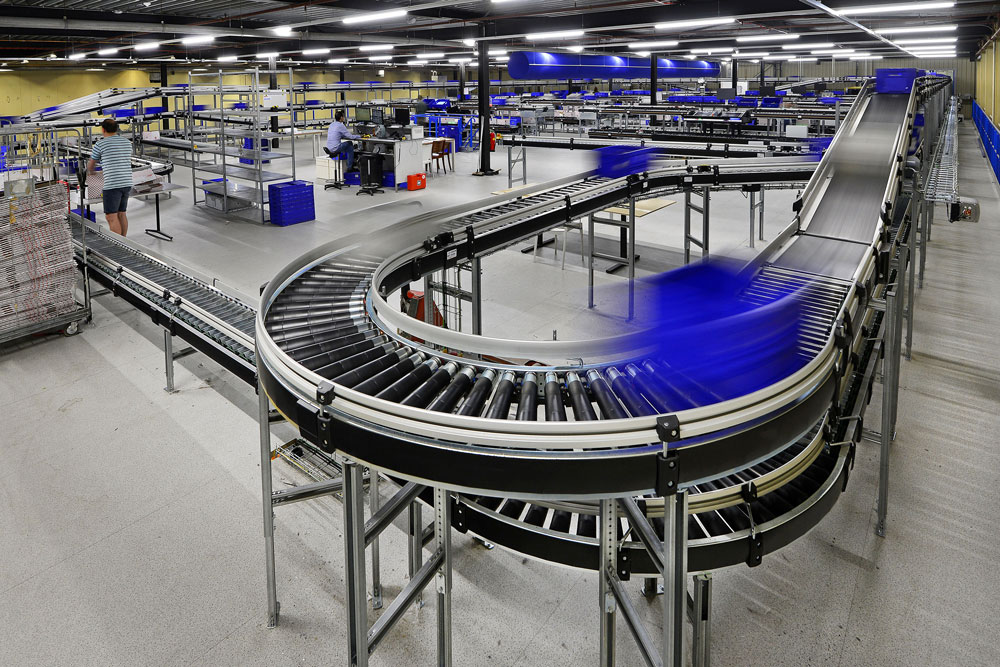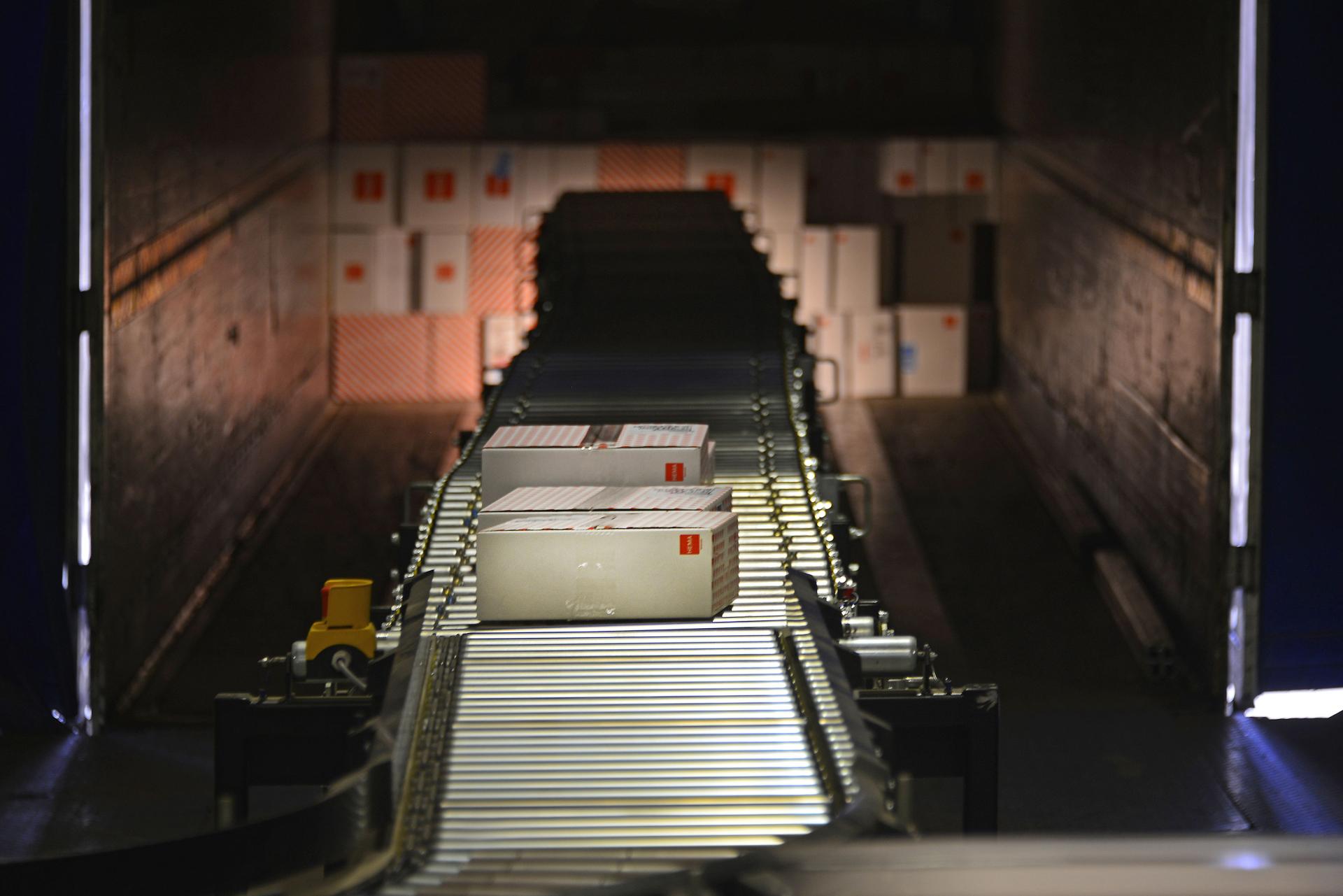21 January 2021
In four years, HEMA has increased the capacity of the e-commerce DC from 80,000 to 130,000 picks per day. The solution consists of a largely automated order picking system from Inther Group, including a miniload and shuttle system, supplemented with smart software for optimal distribution of the workload.
Milestone
HEMA’s e-commerce DC is currently breaking records. On the day before the interview (in the middle of the second corona wave, well before Black Friday) the barrier of 120,000 picks per day was broken for the first time. Caspar de Jong and Jeroen Dietz from HEMA are proud of this milestone. “A year ago, this distribution center still had a theoretical capacity of 110,000 picks per day. We are now moving towards 130,000 picks per day”, says De Jong, Director Global Logistics at HEMA.
The coronavirus has been the main reason for the rapid growth. “When the pandemic broke out in mid-March, we had to scale up from 11 to 21 shifts per week in a short time. Seven days a week, we were busy day and night collecting, packing and shipping orders. After the summer, we had to scale up again in mid-September. First to 18 shifts and since the beginning of November to 21 shifts again”, explains Dietz, Manager E-commerce DC at HEMA.
HEMA supplies from Utrecht not only to online customers from the Netherlands, but also from Belgium, France, Germany and the United Kingdom. For those customers, the online channel is a safe method of shopping, especially at times when the number of corona infections is increasing. HEMA is therefore seeing more and more customers opting for home delivery instead of in-store pick-up. At the moment, home delivery is also the only option. “And HEMA is not alone. We see that the online channel has become an important lifeline for retailers across Europe. This allows them to continue to serve their customers, even during a lockdown”, says Martijn Herder, CEO of Inther Group.
Phased expansion
The fact that the distribution center can process so many orders is the result of a four-year automation process. Since 2016, both storage and order picking capacity has been expanded in phases. “Until then, the operation had been set up purely manually. The order pickers walked with pick carts along the racks with shelf locations at the bottom and pallet locations at the top. 22 reach trucks drove between the order pickers, constantly replenishing the picking stock at the shelf locations. The only mechanization consisted of a roller conveyor, which transported the full boxes from the order picking area to the packing stations”, says Dietz. In 2016, HEMA started an investigation with only one question: how long would the manual distribution center still suffice? The outcome was somewhat surprising.
The maximum capacity would already be reached in 2017. “Then we drew up a plan together with Inther to mechanize and automate parts of the operation. We had to. The volumes became too high to continue to be processed manually in this building.”
Miniload and shuttles
Inther was the first to install a miniload system with space for 13,000 plastic containers. This is where a large part of the bulk stock now lies for replenishment of the pick locations. The two miniload cranes place the necessary bins on a roller conveyor, which transports the new picking stock to the shelf locations. “As a result, reach truck traffic has decreased significantly. Because those reach trucks drove in the same aisles as all those order pickers with their picks, we wanted to get rid of that as quickly as possible. Thanks to that miniload and a second carton sealer, we had enough capacity to get through the high season of 2017”, Dietz explains.
The following year Inther started to expand the order picking capacity. A shuttle system with space for 33,000 plastic containers has been installed for this purpose, of which 5,000 containers are divided into four compartments. The 75 shuttles, divided over three aisles, together are able to transport 2,400 containers per hour to the 8 order picking stations. There is an order picker at each station, who takes the correct number of items from the bin and distributes it to the six ready boxes. “These bins contain the slow movers, which we can pick with a higher frequency than before thanks to this Goods to Person system”, Dietz says.
Smart pick carts
The slow movers cover 60 to 70 percent of the product range, which consists of 14,500 items. The fast movers are still in shelf locations and are still picked using pick carts. “But those are smart pick carts with Pick to Light technology”, Dietz assures. “The display on the cart sends the order picker to the right location. If the order picker scans the correct item, the Pick to Light displays indicate how many pieces he or she has to put in each box. That way, each order picker can handle sixteen orders at the same time.”
When it comes to small orders, HEMA can bundle them into a batch. Each batch is collected in one bin, after which the items are sorted by order again using a putwall. “In this way we can reduce walking distances even further and increase efficiency”, says Dietz. “We had 22 order picking carts, but recently we expanded that number to 28. Partly thanks to the 8 order picking stations and the extra order picking trolleys, we succeeded in increasing the capacity from 80,000 to 130,000 picks per day in four years.”
Full integration
Inther not only supplied the miniload and shuttle system, but also carried out the entire automation process. That also includes a carton erector, label applicators, Automated Document Inserters and the conveyors that connect all machines and systems. The Warehouse Control System for integration and control of the entire system is also taken care of by the Venray based system integrator. “In 2016 we had to switch quickly. Inther had already supplied the pick carts and the Warehouse Management System, knew our operation from oat to barley and was able to get to work quickly”, Dietz explains the choice for Inther.
In the years that followed, HEMA continued to return to Inther. “When purchasing the shuttle system, we asked various suppliers for an offer. But it has great advantages to bring everything under one party, so that one large integrated solution is created”, says Dietz, who is supported by De Jong. “With the completion of this distribution center ten years ago, we laid a foundation to which new elements were constantly added. Each addition has contributed to further optimization of the operation.”
This approach is common for Inther. “Together with our customers we create a ‘customer journey’, in which we continuously expand and improve the system. Software optimization plays a major role in this. With adjustments to the software, we can often achieve enormous improvements in capacity and lead time without having to directly add mechanics”, says Herder.

Workload distribution
An important part of the optimization is a result of Inther’s software. By adding more and more smart logic, we have succeeded in further increasing the capacity of the various used systems. “Take as an example the option of distributing the orders evenly across the system. In the past, when we transferred the online orders from our SAP-system to the WMS, we had no idea how much work was involved. As a result, it was busy in some zones and quite in others”, Dietz explained.
Inther has developed a solution that distinguishes between the type or order. Does it contain order lines for the shelf/bin area, for the shuttle system or for both? Is it a small order that can be combined with other orders into a batch? “We can now see in advance what the impact of orders will be on the workload in the various zones. By carefully planning the release of orders, we can optimally distribute the workload and make even better use of the available capacity”.
Fast and slow moving products
Another important factor concerns the allocation of items. Every week, HEMA makes a prediction of the expected number of picks per item. Does the number of picks increase and does a slow moving product turn into a fast moving product? Then the pick stock is removed from the shuttle system and placed on a shelf location. “That doesn’t always go well”, Dietz laughs. “When the first corona wave broke out in mid-March, the demand for cleaning products rose unexpectedly quickly. Articles that were actually always in the shuttle system suddenly turned into fast moving products.”
In the e-commerce DC there are now 14,500 articles in stock. That is almost the entire range that is in the shops, except for fresh products such as pastry and sausage and dangerous goods that may not be sent by post. “We try to stick to that number of 14,500 articles as closely as possible. We might be able to post more articles in the future, but at the moment that’s the maximum”, says Dietz.
Minimum number of mispicks
Mechanization and automation have not only significantly increased storage and order picking capacity, but also significantly reduced the number of picking errors. The items on the shelf locations are scanned piece by piece during both order picking and packing. At the eight order picking stations that are linked to the shuttle system, LED strips with green and red lights indicate from which compartment to pick and for which box those items are intended. The screen above each picking station shows the corresponding picking instructions. “If the order pickers already made mistakes, it was especially when after a large number of picks with one piece they suddenly had to pick two pieces. We solved this by coloring the screen red when the number of pieces changes. The number of mispicks is now extremely low.”
Preventing mispicks starts at inbound, Dietz emphasizes. Because the storage capacity is limited, the e-commerce DC is supplied daily from the central distribution center a little further away. For receiving and inbound, HEMA has nine fixed and four mobile workstations, where the goods are unpacked and checked. “Everything we receive is fully counted and repackaged in empty containers. Everything for maximum stock reliability.”
Resident Engineering
Dietz is pleased with the reliability and user-friendliness of the chosen solution. Inther also supplies Resident Engineers who take care of the daily care and maintenance of the system. At HEMA this is done in a 24-hour operation. “We are increasingly organizing Resident Engineers and it is in line with our mission to completely unburden customers such as HEMA. We have set up a hub in the center of The Netherlands especially for this purpose, with a team that we are constantly expanding”, says Herder.
User-friendliness is particularly important now that HEMA has to scale up quickly. The number of temporary workers has more than doubled in three weeks. Every day 16 new people start working. “Fortunately, that goes very smoothly. After two days they are already sufficiently trained.”
De Jong: “Due to the rapid growth that we are currently experiencing online, we are already looking forward to scaling up capacity. Simulation must now clarify which solution we can deploy in the long term to continue to meet demand.”

